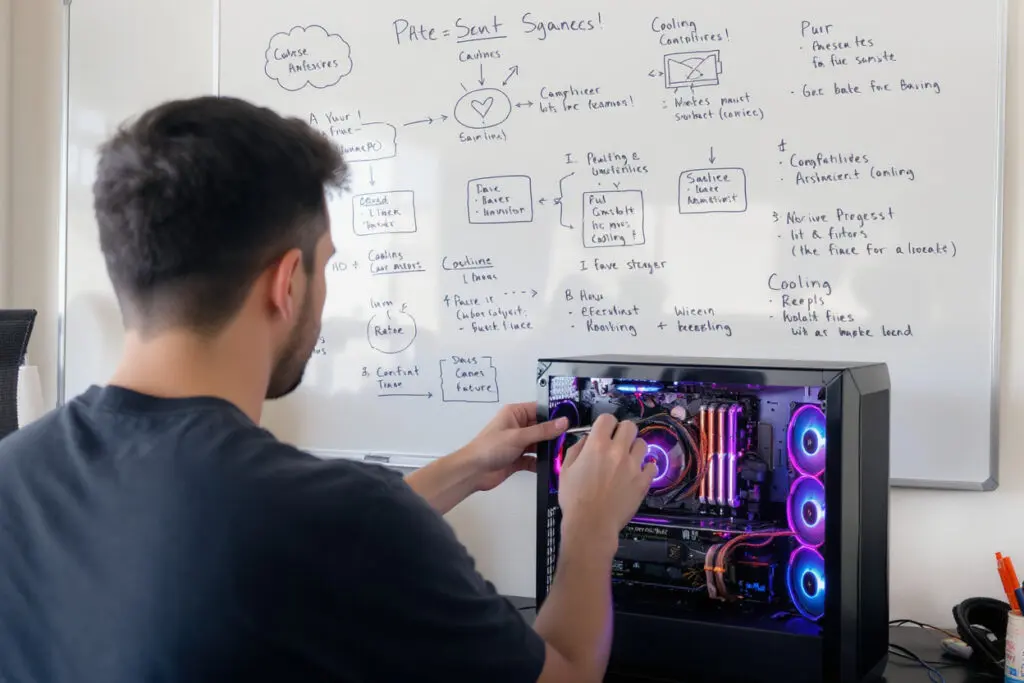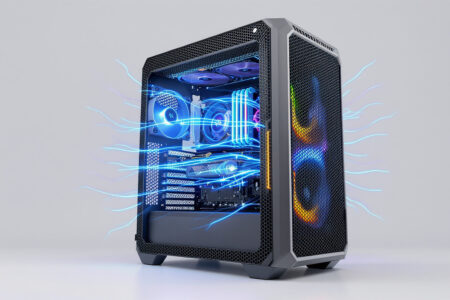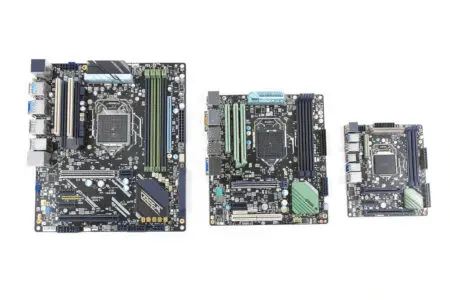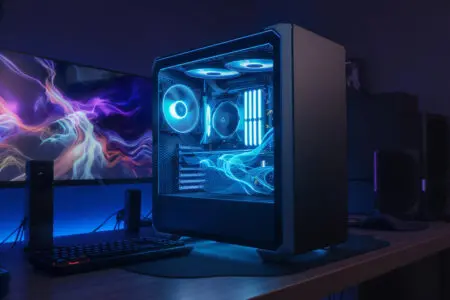Putting together a new gaming PC is an absolute rush. I can still picture my first build: parts spread all over the living room floor like some kind of high-tech Lego set. The CPU, the beast of a graphics card, the RAM… it was awesome. In that chaos of excitement, it’s so easy to overlook the case. To see it as just a box for the “important” stuff. I almost made that mistake myself. But here’s the deal: that “box” is the bedrock of your entire rig.
It decides what fits, how well things cool, and what your masterpiece will actually look like. Figuring out how to choose a PC case for your gaming build is more than just a box-ticking exercise. It’s about protecting your investment and getting the most out of it. We’re going to cut through the noise, figure out what really matters, and find you a case that’s the perfect home for your new hardware. A happy home for happy hardware.
More in Hardware Category
Air cooling vs. liquid cooling
What Is the Best PC Case for Airflow
Key Takeaways
- Size is Everything: Your case has to fit your motherboard (ATX, Micro-ATX, Mini-ITX). Period. Double-check the clearance specs for your graphics card and CPU cooler before you buy.
- Let It Breathe: Airflow is non-negotiable. Look for cases with great ventilation, especially mesh front panels. This keeps your parts from overheating and slowing down. It makes a huge difference.
- Think Ahead: A good case can outlive your other components. Look for modern touches like front USB-C ports and enough room for future upgrades like liquid cooling or more storage drives.
- Build Quality Pays Off: You don’t need the priciest case on the shelf, but investing in one with a solid frame, dust filters, and decent cable management options will save you a world of pain later.
So, Why Does Your PC Case Even Matter So Much?
It’s a totally fair question. When you’re on a tight budget, spending that extra $50 on a beefier graphics card instead of a fancier case seems like a no-brainer. But the case is so much more than a pretty shell. It’s the skeleton, the armor, and the lungs of your gaming rig, all in one.
Isn’t it just a box?
Not even close. Calling a PC case “just a box” is like calling a race car “just a car.” The way that box is designed affects everything you put inside it. A case with bad airflow can literally suffocate your parts, making them run hotter and slower. On the flip side, a well-designed case gives your components a steady stream of cool air, letting them run at their best when you’re deep in a gaming session.
Plus, it’s how you physically interact with your PC every day. It’s where the power button and USB ports are. It’s the thing you have to look at. You want something that works well and doesn’t feel cheap and flimsy.
How does a case protect my expensive parts?
You’re about to put hundreds, maybe thousands, of dollars worth of electronics into this thing. The case is their bodyguard. It’s the first line of defense against dust, spills, bumps, and static electricity that can kill a component in a flash.
I learned this lesson the hard way. Years ago, my cat decided to knock a full glass of water right next to my old test-bench setup, which had no case. My heart stopped. It was a near-disaster that a simple side panel would have completely prevented.
And another thing: dust. Dust is the silent killer of PCs. It gets into fans, blankets your components, and slowly suffocates them, raising temperatures and shortening their lifespan. A good case with easy-to-clean dust filters is an absolute must-have for keeping your PC healthy long-term.
Can a good case really boost my gaming performance?
You bet it can, just not in the way you might think. Your powerful CPU and GPU produce a ton of heat. To stop themselves from cooking, they’re built to automatically slow down—or “throttle”—when they get too hot. When that happens, your frame rates drop and your game starts to stutter. It stinks.
A case with great airflow is the solution. It pulls in cool air, washes it over your hot components, and shoots the hot air out the back. A mesh front panel is a superstar here, letting fans breathe freely compared to a solid piece of glass or plastic. By keeping your parts cool, the case allows them to run at their top speeds for longer. You get the smooth performance you paid for.
What Size PC Case Should I Actually Get?
Picking the right size is the first big decision, and it’s a crucial one. It sets the rules for what parts you can buy and how much of a headache the building process will be. Get this wrong, and you’ll have that sinking feeling when your brand-new GPU won’t fit by half an inch.
Are we talking Full-Tower, Mid-Tower, or something smaller?
PC cases usually fall into three main size classes. These line up with the different sizes of motherboards out there.
- Full-Tower: The absolute units. These things are massive. They have space for the biggest motherboards, tons of drives, and wild custom water-cooling setups. Honestly, unless you’re building a monster PC for bragging rights, a full-tower is probably overkill and will eat up your desk space.
- Mid-Tower: This is the Goldilocks zone. For most gamers, this is the perfect size. Mid-towers are built for the most common motherboard size (ATX) but usually fit the smaller ones, too. They hit that perfect balance of having enough room for high-end parts and good airflow, without being ridiculously huge. My first build was a mid-tower, and I’ve never regretted it. It gave me room to learn without being a pain to handle.
- Small Form Factor (SFF): This is a whole category of compact cases for smaller motherboards (Micro-ATX and Mini-ITX). They’re awesome if you want a powerful PC that doesn’t dominate your desk, or if you want something that looks like a sleek console in your living room. Just be warned: building small is tough. It’s like PC-building Tetris. Space is tight, parts have to be chosen carefully, and managing cables is an art form.
How do I make sure my giant graphics card will fit?
Today’s graphics cards are huge. Seriously, some of them are over a foot long. Before you commit to a case, you have to play detective. Look up the case’s official product page and find the spec for “GPU clearance” or “maximum graphics card length.”
Then, find the exact length of the graphics card you want to buy (it’s on the card maker’s website). Compare the two numbers. Give yourself at least an inch of breathing room if you can. Don’t guess. Check the numbers. Always.
Will my motherboard fit in any case?
Nope. You have to match your motherboard’s “form factor” (its size standard) to the case. The big three are ATX, Micro-ATX (mATX), and Mini-ITX.
It’s simple: bigger cases can usually fit smaller boards. A mid-tower made for an ATX board will have the right screw holes for a smaller mATX board. But you can’t go the other way. You can’t cram a big ATX motherboard into a tiny Mini-ITX case. It just won’t work. Checking this compatibility should be the very first thing you do.
How Do I Keep My Gaming Rig from Overheating?
We know heat is the bad guy. Your case is your primary weapon in the war against high temps. The whole point of its design is to create a wind tunnel that keeps your expensive parts from getting too toasty.
What’s the deal with airflow: solid front panel vs. mesh?
The front of the case is where your PC breathes in. For a long time, the trend was to have a solid front panel, usually glass or plastic, for a super clean look. They can look sharp, but they’re often awful for temperatures because they starve the front fans for air.
A mesh front panel, on the other hand, is all about performance. It’s full of holes, letting your fans pull in a ton of cool air without anything getting in the way. In nearly every head-to-head comparison, mesh-front cases cool components way better than solid-front ones.
For a gaming PC, mesh is almost always the right call. The tiny hit to aesthetics (if you even think it is one) is more than worth the cooling power you get in return.
How many fans do I really need?
Most decent cases ship with a fan or two—usually one in the front pulling air in (intake) and one in the back blowing air out (exhaust). For a basic build, that might be enough to get by.
But for a powerful gaming rig, a better strategy is to create “positive pressure.” All that means is you have more fans pulling air in than blowing it out. A great, common setup is two or three fans in the front as intake, and one in the back and one or two on top as exhaust.
This little trick helps keep dust out, because the air pressure inside the case pushes air out of all the little unfiltered cracks and holes. When you’re looking at a case, see how many fans it comes with and how many total fan mounts it has for future upgrades.
What about water cooling? Will my case support it?
Liquid cooling, especially with those All-in-One (AIO) coolers, is super popular for CPUs now. An AIO uses a radiator to get rid of heat, and that radiator needs a place to live.
Radiators are sized by the fans they use (like 240mm for two 120mm fans, or 360mm for three). A case’s spec sheet will tell you its “radiator support”—where you can mount them and what sizes fit. For instance, it might say it fits a 360mm radiator in the front and a 280mm up top. When I upgraded to a 280mm AIO cooler, I had to triple-check that my case had the right mounting points on top. It’s a critical step if you’re even thinking about liquid cooling. As noted by academic programs like Purdue University’s Computer Graphics Technology, advanced computing requires robust hardware, and that includes top-tier cooling solutions.
What Else Should I Be Looking For in a Gaming PC Case?
Beyond size and cooling, a few key features make the difference between a fun, easy build and a frustrating afternoon of scraped knuckles. These are the thoughtful little details that make life better.
How can I make cable management less of a nightmare?
A rat’s nest of cables behind your motherboard doesn’t just look bad, it can block airflow. A good case makes it easy to be tidy. Look for these things:
- PSU Shroud: This is a metal cover at the bottom that hides your power supply and all the extra cables you don’t use. It’s the fastest way to make a build look clean.
- Cable Routing Channels & Tie-Downs: Good cases have little channels and hooks on the back of the motherboard tray. These let you guide your cables cleanly and zip-tie them down so they stay put.
- Room to Work: You want a decent gap between the motherboard tray and the side panel. It gives you space to run thick cables without having to wrestle the side panel back on.
Are front panel ports (USB-C, etc.) a big deal?
Yes, they are. The ports on the front or top of your case (the “front I/O”) are a big quality-of-life feature. You’ll want at least a couple of standard USB-A ports and audio jacks.
But the real game-changer these days is having a front-panel USB-C port. More and more devices use it, and having a convenient port right there for fast charging your phone or plugging in an external SSD is awesome. Just make sure your motherboard has the right internal connector for it—most new ones do.
Do I need dust filters?
Yes. Seriously. Yes. Dust is the enemy. It will get inside your PC. It will slowly kill your performance.
A quality case must have removable filters on all the main intakes: the front, the top (if you use it as intake), and under the power supply. The magic word is “removable.” You want filters you can easily slide out and rinse off every few months. This single feature will do more to protect your components than almost anything else.
Let’s Talk About Looks: How Do I Choose a Case I Won’t Hate in a Year?
Style is personal, but let’s be real: your PC is basically a piece of furniture. You’re going to see it every day, so pick something you actually like the look of. The trick is to find a balance between what’s trendy now and a design that won’t look dated in a year.
Tempered glass or solid side panel?
The see-through tempered glass side panel is everywhere now. It lets you show off all the components you spent your hard-earned money on. If you’re proud of your build and like seeing the lights and fans spinning inside, glass is the way to go. It turns your PC into a conversation piece.
But if you just want a quiet, stealthy black box, there’s nothing wrong with a classic solid side panel. In fact, cases with solid panels are often a bit quieter, especially if they have sound-dampening foam. This is 100% up to you.
To RGB or not to RGB? That is the question.
Ah, RGB. The rainbow unicorn lighting that has taken over PC gaming. I definitely went through a serious “more is more” RGB phase. My PC looked like a rave. It was fun for a bit, but eventually, I just found it distracting.
My advice? Find a case with tasteful, controllable RGB. A lot of great cases have a subtle light strip or fans that you can change to any color you want—or turn off completely. That flexibility is key. A case that’s stuck in permanent rainbow mode is going to get old, fast.
What materials are PC cases even made of?
The bones of almost every case are made of steel for strength. The outside panels are where you see more variety. Cheaper cases use a lot of plastic, which does the job but can feel a little chintzy.
Nicer cases often use aluminum for the exterior, which is lighter and just feels more premium. And of course, the side panel is usually either steel or tempered glass. No matter the price, a good case should feel solid. The panels should line up properly, and it shouldn’t rattle when you move it.
How Much Should I Spend on a PC Case?
Alright, the final question: the budget. You can find cases for under $50 and cases for over $500. As with most things, the sweet spot for most people is somewhere in the middle.
Is a cheap case going to ruin my build?
It’s not going to catch fire, but going for a super-cheap case comes with real trade-offs. You’re giving up a lot:
- Bad Airflow: They almost always have those solid, choked-off front panels.
- Cheap Materials: Thin metal that bends easily and plastic that feels brittle.
- No Features: Forget about good cable management, decent dust filters, or modern ports.
- A Pain to Build In: Get ready for sharp metal edges and a frustrating experience.
You can use a dirt-cheap case, but it’s one of the worst places to cut corners.
What do I get for spending more money on a premium case?
When you step up into the $80 to $150 range, the difference is night and day. This is where you get the good stuff:
- Awesome Airflow: Smart, mesh-heavy designs built for cooling.
- Solid Build Quality: Thicker materials and a premium feel.
- All the Features: Great cable management, full sets of dust filters, and often some high-quality fans are thrown in.
- A Joy to Build In: Thoughtful designs make the process smoother and more fun.
Think of it this way: a fantastic case is an investment. It can easily last you through several PC upgrades over the next decade. It protects all your other expensive parts and it’s the piece of your setup you interact with the most. Choose wisely. You’ll be glad you did.
FAQ – How to Choose a PC Case for Your Gaming Build

What features should I look for to ensure good airflow and cooling in my gaming PC case?
Look for cases with good ventilation, preferably with mesh front panels that allow more airflow compared to solid panels. Multiple fan mounts for intake and exhaust, and support for liquid cooling radiators are also important to maintain optimal temperatures and prevent overheating during intensive gaming sessions.
How can I prevent my gaming PC from overheating?
To prevent overheating, choose a case with excellent airflow design, including mesh panels and multiple fan mounts. Using additional fans to create positive pressure inside the case and checking for compatibility with liquid cooling radiators can also help keep your components cool and running efficiently.
How do I determine the correct size of a PC case for my components?
You need to match the case size to your motherboard’s form factor, such as ATX, Micro-ATX, or Mini-ITX, and ensure there’s enough space for your graphics card and CPU cooler. Mid-tower cases are most popular for their balance of space and manageability, while full-tower cases are suited for extensive cooling and hardware, and small form factor cases are best for compact builds.
Why is choosing the right PC case so important for my gaming build?
Choosing the right PC case is vital because it directly affects your hardware’s cooling, protection, compatibility, and overall aesthetic. A well-chosen case ensures your components stay cool, are safeguarded from dust and damage, and fit properly, enhancing your gaming performance and experience.





